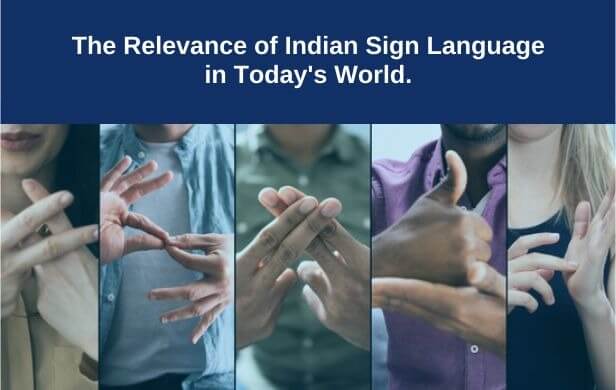





According to the World Federation of the Deaf, there are more than 70 million deaf people worldwide. More than 80% of them live in developing countries. Did you know that collectively, they use more than 300 sign languages?
The Rights of Persons with Disabilities Act 2016 came into force from April 19, 2017 in India . It recognises sign languages as a means of communication with persons with hearing disability. Sign language is a medium of communication for and with people who are deaf. Visual cues like hand gestures, signals, facial expressions, and body movements are used for sign language worldwide.
Indian Sign Language (ISL) is a natural visual-manual language native to the deaf community of India and used by both Deaf and Hard of Hearing communities. ISL uses gestures to represent complex words and sentences. It contains 33 hand poses, including 10 digits and 23 letters. Amongst the letters in ISL, the letters ‘h’, and ‘j’ are represented by gestures, and the letter ‘v’ is similar to digit 2.
Indian Sign Language (ISL) has developed over the past century and has been taught since 2001. As per BBC, about 700 Indian schools teach sign language. ISL has unique grammar and gestures, but some regional differences exist.
It was Sibaji Panda, a deaf teacher, who created and introduced the first-ever formal training course in ISL at the Ali Yavar Jung National Institute of Speech and Hearing Disabilities (AYJNISHD), in 2001. Panda is the founding member of the Indian Sign Language Teacher’s Association (ISLTA) and the Indian Sign language Interpreter’s Association (ISLIA).
In 2011, the Indian Ministry of Social justice and Empowerment helped set up the Indian Sign Language Research and Training Centre (ISLRTC) at the Indira Gandhi National Open University (IGNOU). This centre, however, was shut down and re-established in 2015 as a Society under the Ministry of Social Justice and Empowerment’s (MSJE) Department of Empowerment of Persons with Disabilities.
There is a general lack of awareness in India about sign languages, even among members of the deaf community. Many parents do not know how to communicate with their deaf children. Often, deaf people are ridiculed or ignored by others who can hear.
Learning ISL can bridge these gaps and create sensitivity towards the deaf community and their culture. There are less than 300 ISL-certified interpreters, and more are required. ISL visual dictionaries are also available to help learn the language better.
ISL holds a very important place in today's world. Its goals are:
Launch of Indian Sign Language Dictionary App: ISLRTC launched the Indian Sign Language Dictionary (ISL Dictionary) on 17 February 2021. This dictionary is being used by deaf people, special teachers, parents of deaf children, linguists, researchers, interpreters, etc. and its popularity is increasing day by day. Now to make this ISL dictionary easily available and more accessible, ISLRTC entered into a Memorandum of Understanding (MoU) with Federal Institute of Science and Technology (FISAT), Kerala for the development of the Indian Sign Language Dictionary APP, which resulted in the creation of an APP known as Sign Learn which was launched during the programme.
Launch of e-content of NCERT Class 6 books in Indian Sign Language jointly developed by ISLRTC and NCERT: ISLRTC signed an MoU with National Council of Educational Research and Training (NCERT) on 06th October 2020 for converting NCERT textbooks from Class I to XII into Indian Sign Language (digital format) to make the textbooks accessible to children with hearing disabilities. Class VI of NCERT textbooks has been completed and e-Content in the ISL was launched during the programme.
Under Azadi ka Amrit Mahotsav, the Centre has converted selected books of the National Book Trust on Veergatha series in ISL. With the joint effort of ISLRTC and NCERT, a total of 500 academic words were launched in the Indian Sign Language. These academic words have been selected from the NCERT textbooks. Educational terms in Indian sign language have been developed by deaf experts and their validity has also been established by the deaf community. These 500 academic words are words used at the secondary level, which are often used in history, science, political science, and mathematics.
Language Services Bureau provides Sign Language Interpreters to support events where the hearing impaired or hard of hearing people may be present.
For any queries related to language translation services. Inquire at our email address below or give us a call today!
info@languageservicesbureau.com
Telephone: +91-20-24470509, +91-82370 60559
Similar articles for you...

आमच्या गेल्या महिन्यातील ब्लॉग मध्ये भाषांचे ज्ञान आवश्यक असणाऱ्या करियर क्षेत्रांची माहिती आपल्याला मिळाली. जिथे भाषेचे ज्ञान फायद्याचे ठरते असे इतर व्यवसाय आपण या महिन्यात पाहुयात.

Posted by : Language Services Bureau

The time it takes to learn a language depends on what you want to do with it– here is a great article about language learning and the kind of expectations you can set about the time required for the same!